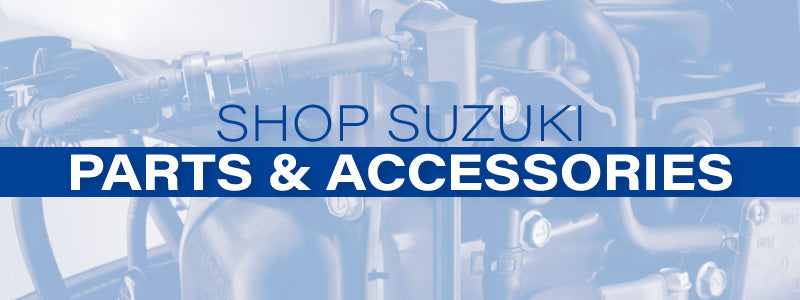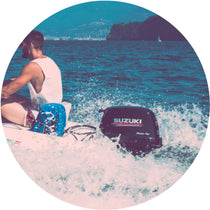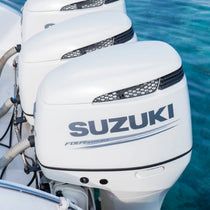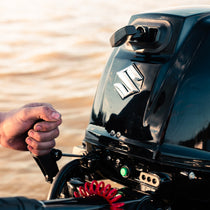There’s nothing worse when you’re out on the water than your Suzuki outboard motor not running how you’d like it to. With a Suzuki outboard running rough, you might experience unwanted vibrations, lower than optimal RPM, and even a smoking engine. If your Suzuki outboard doesn’t start at all, you’re dead in the water (or in the dock, as the case may be).
As with most issues, using only OEM Suzuki outboard parts and Suzuki marine parts is a good recipe for keeping your outboard running in optimal condition. However, even performing all required maintenance intervals (with Suzuki outboard maintenance kits), you still may encounter issues on the water.
This article will look at several performance issues related to your Suzuki outboard running rough or not at all and some easy-to-follow tips for addressing each potential problem. Ultimately, at PartsVu, we want to help you enjoy every day on the water.
Suzuki Outboard Won’t Start
If your outboard doesn’t start, you’ll need to start from the most obvious causes, then move to more complicated possibilities. Here’s a run-down:
- Make sure that the kill cord is attached.
- Because your Suzuki outboard won’t start in gear, ensure the engine is in neutral.
- Inadequate fuel supply is a common issue, either from pinched hoses or a lack of fuel in the gas tank(s).
- Make sure that there’s no water in the fuel lines. Perform a visual inspection in the water separator bowl for traces of water.
- Look for fouled spark plugs (more common in small engines). If any fouled plugs are discovered, replace them with new spark plugs.
- Test your battery to ensure that it has adequate voltage. If it is underperforming or dead, consider replacing the battery and checking for any shorts that may be draining it.

Suzuki Outboard Running Rough (Misfires)
If you’ve managed to get your Suzuki engine started but still experience a rough or uneven idle, then the chances are that your engine is misfiring. Here’s a list of possible causes of why your Suzuki outboard is running rough:
- Fuel quality is a big factor when your Suzuki outboard is running rough. Due to the high ethanol content in some marine fuels, “phase separation” may occur and introduce water into the fuel, ultimately causing a lack of even combustion. Consider using a fuel stabilizer every time you fill-up. Also, keep your fuel tank as close to full as possible to prevent water infiltration.
- Water may also short out any electrical connections, so use a voltage tester to determine the source. This is especially common for improperly winterized boats or those stored near aquatic environments.
- Look for loose connectors that may have vibrated off or were not attached properly after servicing. On most Suzuki models, a warning for a faulty component will show up on your instrument panel to help you service your outboard and determine the source of the issue.
- The fuel pump is responsible for bringing gas to your engine from your fuel tank. When it is not operating optimally, you may notice the outboard bogging down when you throttle up or idling. Consider a complete replacement of the fuel pump to fix this problem.
Suzuki Outboard Hesitates on Acceleration
If you’re ready to throttle up, only to feel a hesitation, the chances are that you’ve got an issue with your Suzuki outboard motor. Typically, an outboard that hesitates is related to the fuel supply and other related issues:
- A closed or blocked air vent on the fuel tank. Ensure that the air vent of your fuel tank is completely open and free from any obstructions. Look underneath the cowling for any debris, especially animal nests, leaves, and tree sap.
- Dirty or restricted fuel filters can cause intermittent acceleration issues. Check all fuel filters and remove any restrictions and contamination. Consider replacing the filters if the problem persists and only use genuine OEM Suzuki outboard parts for replacement.
- Inspect the fuel lines for any bad connections, pinched lines, damage to the line, and leakage issues.
- Inspect your fuel pump to see if it is in proper working condition. A malfunctioning fuel pump will often cause uneven acceleration until it eventually degrades and requires immediate replacement.
- Check for malfunction in the thermal relief valve. If the thermal relief valve is jammed or closed, the outboard motor will continue to run but will run rich on the idle setting. However, if the valve is stuck open, your engine will likely exhibit characteristics of a cold start.

Suzuki Outboard Overheats
One of the most common ways an outboard can fail is when it overheats during use. From your temperature gauge being in the red, seeing or smelling smoke, or uneven performance, the following are some of the most common reasons why your Suzuki outboard is overheating:
- Look first on your instrument panel for warnings to alert you to an overheating issue.
- Debris that’s blocking the water intake is the most common overheating issue. Look for plastic bags or seaweed blocking the intake and verify the issue by looking for water coming out of the telltale hole.
- When the water pump impeller is worn, clogged, or misshapen, the ability to cool the engine is drastically reduced. This, in turn, leads to the engine overheating, triggering mechanisms that prevent the engine from functioning at high temperatures. If your outboard does not throttle up, the impeller may be the culprit and need to be replaced.
Suzuki Outboard is Over-Revving
If your Suzuki outboard is over-revving— where you’re throttling up the RPMs with a noticeable drop in performance— the most likely cause is related to your propeller. This can be related to the prop’s pitch, or the choice of propeller is not adequate for your boat’s size.
Also, pay attention to what’s referred to as a “spun prop.” A spun prop occurs when the bond between your boat propeller and the prop shaft is damaged, resulting in the rubber inserts spinning independently. This feels like a loss of power with excessive RPM.
Closing Thoughts
We hope this article sheds some light on why your Suzuki outboard motor is not running in optimal condition. If this troubleshooting guide provided no results, consider consulting a professional and certified Suzuki outboard mechanic to explore more advanced possibilities.
Shop for the Suzuki outboard parts you need with PartsVu, including genuine OEM Suzuki marine parts and Suzuki outboard maintenance kits.
PartsVu’s mission is to help provide you with the knowledge, insights, parts, and products to help you enjoy every day you can spend on the water. Visit PartsVu.com to shop our offering of more than 200,000 boat parts, products, and accessories for a marine lifestyle.




















7 comments
Hello Mario,
Experiencing a temperature alarm at a specific RPM or when throttling down could indicate a few potential issues with your Suzuki DF140 outboard. Here are some common reasons for overheating or triggering a temperature alarm:
Impeller/Water Pump Failure: The impeller is a vital component responsible for pumping water to cool down the engine. Over time, impellers can wear out, reducing their efficiency. If it’s not circulating enough cooling water, the engine can overheat.
Thermostat Issue: The thermostat regulates the flow of coolant based on engine temperature. If it’s malfunctioning, it might not allow enough coolant to flow, causing the engine to overheat.
Clogged Cooling Passages: Debris, sand, salt, or marine growth can clog the passages that allow cooling water to circulate. Regular flushing of the engine, especially if used in salt water, can help prevent this.
Faulty Temperature Sensor: Sometimes, the issue isn’t with the cooling system but with the sensor that detects temperature. If the sensor is faulty, it can trigger the alarm even if the engine is not genuinely overheating.
Cooling System Airlock: Air trapped in the cooling system can cause a lack of coolant flow, leading to overheating.
Over-rev Protection: If you’re operating close to the engine’s max RPM, some outboards have an over-rev protection feature that can reduce RPM or trigger an alarm if the engine is revved too high.
Engine Oil: Low engine oil or old, degraded oil can cause the engine to run hotter than normal.
Immediate Steps:
-Check the water intake for any blockages or debris.
-Verify the tell-tale stream (the “pee” stream) is consistent and strong, indicating the water pump is working.
-Inspect the impeller and water pump for wear or damage.
-Test or replace the thermostat.
-Flush the engine with freshwater after every use, especially after operating in salt or muddy water.
-Check engine oil levels and quality.
If the issue persists, it’s essential to get the engine checked by a professional or a certified Suzuki technician to pinpoint the exact problem and prevent any potential engine damage. Avoid running the engine at high RPMs until the issue is addressed.
While running at 5800 rpms is on a Suzuki df 140 when i throttle down the temperature alarm. Comes on i shut the engine off and turn it right on and alarm gone
Hello Thomas,
If your Suzuki 60hp outboard motor is not producing the “bip” or alarm sound when you turn the key on, there could be several potential reasons for this issue. Here are some common troubleshooting steps to help you identify and potentially resolve the problem:
1. Check the Key Switch:
– Ensure that the key switch is turned to the “On” position and is functioning correctly. Sometimes, a loose or faulty key switch can prevent the alarm from sounding.
2. Battery Voltage:
– Inspect the battery voltage. If the battery is weak or discharged, it may not provide enough power to activate the alarm system. Charge or replace the battery if necessary.
3. Wiring and Connections:
– Inspect the wiring and connections between the key switch and the alarm system. Loose or corroded connections can interrupt the signal. Make sure all connections are clean, tight, and free from corrosion.
4. Alarm System:
– The alarm system itself may be faulty or have a blown fuse. Check the alarm system’s wiring and fuse to ensure they are intact.
5. Oil Level:
– Many outboard motors have an oil level sensor that triggers an alarm if the oil level is too low. Check the oil level in the oil reservoir and top it off if needed.
6. Engine Overheating:
– Some outboard motors have an overheating alarm. Ensure that the engine is not overheating, as this can trigger the alarm. Check for any obstructions in the water intake and make sure the cooling system is functioning properly.
7. Other Safety Features:
– Review your owner’s manual to check if there are any other safety features or sensors that could trigger the alarm. Ensure that all systems are functioning correctly.
8. Professional Inspection:
– If you have checked all the above and the problem persists, it’s advisable to have your outboard motor inspected by a certified Suzuki technician or a qualified marine mechanic. They can use specialized diagnostic tools to pinpoint the issue accurately.
Remember that the exact cause of the issue may vary depending on your specific outboard motor model and its features, so consulting your owner’s manual and seeking professional assistance if needed is essential for a proper diagnosis and resolution. Additionally, always prioritize safety when working on or around marine engines.
If none of this seems like your issue email us at Partsvu@partsvu.com with more details.
Best,
Mario
My Suzuki 60hp doesnt do the “bip (alarm)” when I turn the key on. What could it be? Thanks
$5500 repair and then on first trip out after repair 20 miles out and propeller stopped motor runs came back in on other engine at 9 miles an hour. Suxs